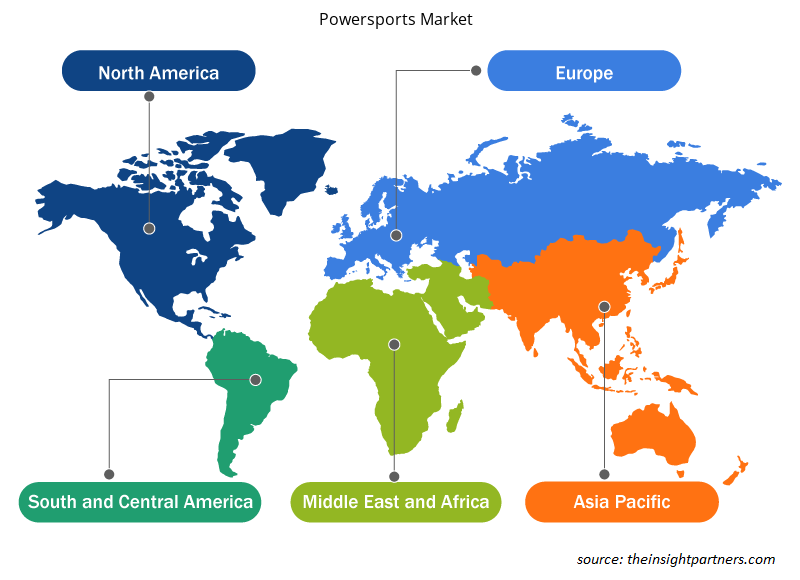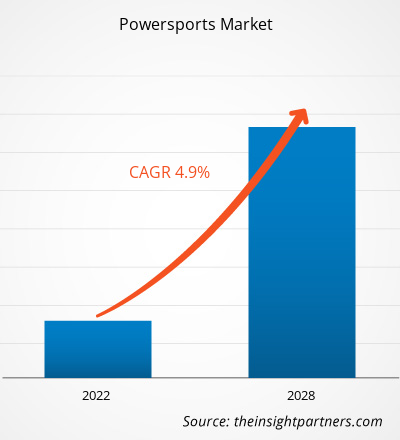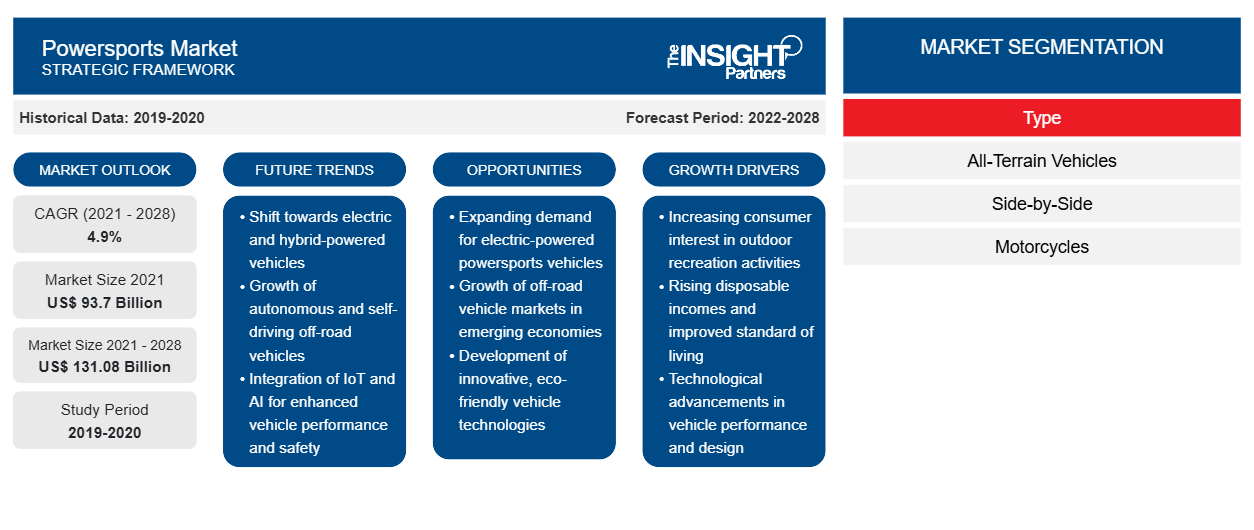[Forschungsbericht] Der Powersports-Markt soll von 93.703,64 Millionen US-Dollar im Jahr 2021 auf 131.083,20 Millionen US-Dollar im Jahr 2028 wachsen; für den Zeitraum 2021–2028 wird eine durchschnittliche jährliche Wachstumsrate (CAGR) von 4,9 % geschätzt.
Beim Abenteuertourismus geht es darum, an neue Orte zu reisen, um neue Erfahrungen zu sammeln, mit kontrollierten Risikokomponenten und persönlichen Herausforderungen in wilder und exotischer Umgebung. Eine steigende Zahl von Besuchern, die sich für Geländefahrten interessieren, trägt zum Wirtschaftswachstum des jeweiligen Landes bei.
Powersports generiert in Malaysia durch Ausgaben für Unterkunft, Logistik und Tourismus jährlich über 1,15 Milliarden US-Dollar . Zu den in Malaysia ausgerichteten Rennveranstaltungen zählen der Motorcycle Grand Prix (MotoGP), die Asia Road Racing Championship (ARRC) und der Malaysian Cub Prix. Diese Veranstaltungen bringen erhebliche gesellschaftliche und wirtschaftliche Vorteile. Dass derartige Rennveranstaltungen unter Sporttouristen weithin bekannt sind, ist das Herzstück des Motorsporttourismus. Die lange Dauer der Veranstaltungen, die Sichtbarkeit und Berichterstattung in den Print- und elektronischen Medien, das Sponsoring durch nationale und internationale Firmen und die enormen wirtschaftlichen Möglichkeiten für die Einheimischen sind alles Vorteile von Motorsporttourismuszielen. Faktoren wie ein hohes Energieniveau, Tatendrang und Reiselust der Menschen sind die wichtigsten Faktoren für das Reisemotiv. Für viele ist der Wunsch, neue und gleichgesinnte Leute mit ähnlichen geselligen Interessen kennenzulernen, eine treibende Kraft für das Offroad-Fahren. Diese Eigenschaften führen zum Wachstum des Powersports-Marktes.
Passen Sie diesen Bericht Ihren Anforderungen an
Sie erhalten kostenlose Anpassungen an jedem Bericht, einschließlich Teilen dieses Berichts oder einer Analyse auf Länderebene, eines Excel-Datenpakets sowie tolle Angebote und Rabatte für Start-ups und Universitäten.
-
Holen Sie sich die wichtigsten Markttrends aus diesem Bericht.Dieses KOSTENLOSE Beispiel umfasst eine Datenanalyse von Markttrends bis hin zu Schätzungen und Prognosen.
Auswirkungen der COVID-19-Pandemie auf den globalen Powersports-Markt
Vor der COVID-19-Pandemie wuchs der Powersports-Markt aufgrund des zunehmenden Handelsverkehrs mit Geländefahrzeugen (ATVs). So stieg beispielsweise das Interesse der Verbraucher an Geländefahrzeugen, Geländefahrzeugen (UTVs) und speziellen Powersports-Einheiten in den ersten sieben Monaten des Jahres 2019 um 35 %, basierend auf Suchanfragen im Jahresvergleich auf dem ATV Trader-Marktplatz von Trader Interactive. Der ATV-Handelsverkehr wächst monatlich konstant schneller, was eine Marktverschiebung widerspiegelt, die Powersports-Händlern helfen kann, stagnierende Motorradverkäufe auszugleichen. Die sprunghaft gestiegenen ATV-Handelsverkehrszahlen unterstützten das Wachstum des Powersports-Marktes im Jahr 2019.
Im Jahr 2020 wirkte sich die COVID-19-Pandemie aufgrund des Rückgangs der globalen Automobilindustrie negativ auf den Powersports-Markt aus. Der Ausbruch führte zu erheblichen Störungen bei der Herstellung von Produkten, einschließlich Autos. Ein starker Rückgang der Automobilherstellung wirkte sich auf das Wachstum des globalen Powersports-Marktes aus. Darüber hinaus zeigten die von der Organisation Internationale des Constructeurs d'Automobiles (OICA) gesammelten Daten einen Rückgang der Gesamtfahrzeugproduktion im Jahr 2020 um 16 % auf weniger als 78 Millionen Fahrzeuge. Darüber hinaus wurden zur Bekämpfung und Eindämmung des Ausbruchs Fabrikschließungen, Reiseverbote, Handelsverbote und Grenzschließungen verhängt; diese Beschränkungen wirkten sich negativ auf die Herstellung, Versorgung und den Verkauf verschiedener Automobilkomponenten aus, die zur Herstellung von Autos erforderlich sind. Daher waren die Auswirkungen von COVID-19 auf den Powersports-Markt im Jahr 2020 insgesamt negativ.powersports market due to the decline in the global automotive industry. The outbreak created significant disruptions in the manufacturing of products, including cars. A sharp decline in manufacturing automobiles impacted the growth of the global powersports market. Further, the data collected from the Organisation Internationale des Constructeurs d'Automobiles (OICA) showed a 16% decline in 2020 total number of vehicle production to less than 78 million vehicles. Moreover, to combat and contain the outbreak, factory shutdowns, travel bans, trade bans, and border lockdowns were imposed; these restrictions negatively impacted the manufacturing, supply, and sales of various automobile components required to manufacture cars. Therefore, the overall COVID-19 impact on the powersports market was negative in 2020.
In den Jahren 2021 und 2022 unterstützen die Lockerung der Lockdown-Maßnahmen und die Produktionssteigerung von Powersport-Fahrzeugen das Marktwachstum. Laut einem im Juli 2021 von Babcox Media Inc. veröffentlichten Artikel stiegen die Verkäufe neuer Modelle führender Marken im ersten Quartal 2021 um mehr als 37,2 %.lockdown measures and increase in production of powersport vehicles are supporting the market growth. As per an article published by Babcox Media Inc. in July 2021, new-model sales of leading brands increased more than 37.2% in the first quarter of 2021.
Vor der COVID-19-Pandemie im Jahr 2019 betrug die Größe des Powersport-Marktes 95.728,13 Millionen US-Dollar. Die Marktgröße während der Pandemie betrug im Jahr 2020 91.324,63 Millionen US-Dollar. Darüber hinaus betrug die Größe des Powersport-Marktes im Jahr 2021 93.703,64 Millionen US-Dollar. Daher waren die Gesamtauswirkungen der COVID-19-Pandemie auf den Powersport-Markt im Jahr 2020 negativ.powersports market size was US$ 95,728.13 million. The market size during the pandemic was US$ 91,324.63 million in 2020. Furthermore, in 2021, the powersports market size was US$ 93,703.64 million. Therefore, the overall impact of the COVID-19 pandemic on the powersports market was negative in 2020.
Einblicke in den Powersports-Markt Market Insights
Zunahme der Beliebtheit von Geländefahrzeugen und Erlebniszonen
Aufgrund ihrer besseren Leistung auf schwierigem und unebenem Gelände sind All-Terrain-Fahrzeuge (ATVs) mit vier Rädern bei den Verbrauchern sehr gefragt. Dies veranlasst die ATV-Hersteller dazu, ein Allradsystem als optionale Funktion oder als permanente Option einzubauen. Mikrofaserkupplungen erkennen die Notwendigkeit eines Allradsystems in Echtzeit. Die Beliebtheit solcher neuen Allrad-ATVs nimmt in verschiedenen Ländern zu. Beispielsweise veranstaltet der Canadian Council of Snowmobile Organization jedes Jahr Sportwettbewerbe. Darüber hinaus veranstalten mehrere große ATV- und UTV-Hersteller Rennmeisterschaften, was die Nachfrage nach diesen Nutzfahrzeugen voraussichtlich steigern wird. In den USA gibt es immer mehr Freizeitparks für ATV-Fahrten. Auf öffentlichem Land im Land wurden Freizeitmöglichkeiten geschaffen, indem über 19 nationale Freizeitrouten um Meilen erweitert wurden. ATVs werden auch häufig von den Streitkräften verwendet, einschließlich Militär- und Polizeibehörden, wo sie häufig für den Transport an abgelegenen Orten eingesetzt werden. Infolgedessen ist die steigende Nachfrage nach Geländefahrzeugen (ATVs) für den Freizeit-, Sport- und Militärbereich einer der Hauptfaktoren für das Wachstum des Powersport-Marktes.
In Industrieregionen wie Nordamerika und Europa sind ATV-Erlebniszonen weit verbreitet. Darüber hinaus konzentriert man sich zunehmend darauf, die Zahl dieser Zonen in Schwellenmärkten wie Indien und südostasiatischen Ländern zu erhöhen, um das Bewusstsein für und die Nachfrage nach Nutzfahrzeugen zu steigern. Kunden können an diesen Standorten mit ATVs auf künstlichen Geländeflächen fahren. So baute Polaris 2018 beispielsweise eine Erlebniszone in Bengaluru, Indien, um seinen Kundenstamm zu vergrößern.
Typbasierte Markteinblicke
Nach Typ ist der Powersports-Markt in Geländefahrzeuge, Side-by-Sides und Motorräder unterteilt . Das Motorradsegment führte den Markt mit dem größten Anteil im Jahr 2020 an.
Die Akteure auf dem Powersports-Markt verfolgen Strategien wie Fusionen, Übernahmen und Marktinitiativen, um ihre Position auf dem Markt zu behaupten. Nachfolgend sind einige Entwicklungen der wichtigsten Akteure aufgeführt:
- Im März 2022 brachte BRP anlässlich des 50-jährigen Jubiläums der Marke Can-Am elektrische Zweiradmotorräder auf den Markt. Die Marke Can-Am kehrt mit einer kompletten Produktlinie auf Elektrobasis zu ihren Motorradwurzeln zurück. Mit Elektromotorrädern bietet sich eine großartige Gelegenheit, auf dem Motorradmarkt erfolgreich zu sein.
- Im März 2021 brachte American Landmaster ein mit Lithium betriebenes Side-by-Side-Fahrzeug namens Landmaster EV auf den Markt. American Landmaster ist eine Partnerschaft mit den beiden branchenweit führenden Unternehmen für Lithiumtechnologie und Wechselstrommotoren eingegangen.
Regionale Einblicke in den Powersports-Markt
Die regionalen Trends und Faktoren, die den Powersports-Markt während des Prognosezeitraums beeinflussen, wurden von den Analysten von Insight Partners ausführlich erläutert. In diesem Abschnitt werden auch die Marktsegmente und die Geografie des Powersports-Marktes in Nordamerika, Europa, im asiatisch-pazifischen Raum, im Nahen Osten und Afrika sowie in Süd- und Mittelamerika erörtert.

- Holen Sie sich die regionalspezifischen Daten für den Powersports-Markt
Umfang des Powersports-Marktberichts
| Berichtsattribut | Details |
|---|---|
| Marktgröße im Jahr 2021 | 93,7 Milliarden US-Dollar |
| Marktgröße bis 2028 | 131,08 Milliarden US-Dollar |
| Globale CAGR (2021 - 2028) | 4,9 % |
| Historische Daten | 2019-2020 |
| Prognosezeitraum | 2022–2028 |
| Abgedeckte Segmente |
Nach Typ
|
| Abgedeckte Regionen und Länder |
Nordamerika
|
| Marktführer und wichtige Unternehmensprofile |
|
Marktteilnehmerdichte: Der Einfluss auf die Geschäftsdynamik
Der Powersports-Markt wächst rasant, angetrieben durch die steigende Endverbrauchernachfrage aufgrund von Faktoren wie sich entwickelnden Verbraucherpräferenzen, technologischen Fortschritten und einem größeren Bewusstsein für die Vorteile des Produkts. Mit steigender Nachfrage erweitern Unternehmen ihr Angebot, entwickeln Innovationen, um die Bedürfnisse der Verbraucher zu erfüllen, und nutzen neue Trends, was das Marktwachstum weiter ankurbelt.
Die Marktteilnehmerdichte bezieht sich auf die Verteilung der Firmen oder Unternehmen, die in einem bestimmten Markt oder einer bestimmten Branche tätig sind. Sie gibt an, wie viele Wettbewerber (Marktteilnehmer) in einem bestimmten Marktraum im Verhältnis zu seiner Größe oder seinem gesamten Marktwert präsent sind.
Die wichtigsten auf dem Powersports-Markt tätigen Unternehmen sind:
- Amerikanischer Landmeister
- Polarkatze
- BRP
- Hisun Motors Corp., USA
- Kawasaki Motors Corp
Haftungsausschluss : Die oben aufgeführten Unternehmen sind nicht in einer bestimmten Reihenfolge aufgeführt.

- Überblick über die wichtigsten Akteure auf dem Powersports-Markt
Firmenprofile
- Amerikanischer Landmeister
- Polarkatze
- BRP
- Hisun Motors Corp., USA
- Kawasaki Motors Corp
- Polaris Inc.
- Yamaha Motor Corporation
- Suzuki Motor USA
- Volcon ePowersports
- Amerikanische Honda Motor Company, Inc.
- Historische Analyse (2 Jahre), Basisjahr, Prognose (7 Jahre) mit CAGR
- PEST- und SWOT-Analyse
- Marktgröße Wert/Volumen – Global, Regional, Land
- Branchen- und Wettbewerbslandschaft
- Excel-Datensatz
Aktuelle Berichte
Erfahrungsberichte
Grund zum Kauf
- Fundierte Entscheidungsfindung
- Marktdynamik verstehen
- Wettbewerbsanalyse
- Kundeneinblicke
- Marktprognosen
- Risikominimierung
- Strategische Planung
- Investitionsbegründung
- Identifizierung neuer Märkte
- Verbesserung von Marketingstrategien
- Steigerung der Betriebseffizienz
- Anpassung an regulatorische Trends























 Kostenlose Probe anfordern für - Powersports-Markt
Kostenlose Probe anfordern für - Powersports-Markt